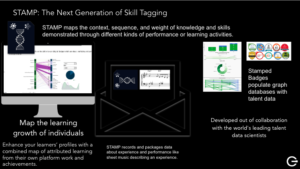Revolutionizing Learning Management Systems with STAMP: A Game-Changer for Organizations
Learning Management Systems (LMS) have become indispensable tools for organizations striving to deliver effective training and education. These platforms empower educators, trainers, and learners by offering a centralized hub for course content, assessments, and tracking progress. However, the evolution of technology and the increasing demand for data-driven insights have exposed limitations in traditional LMS solutions. Enter the Standardized Talent Asset Mapping Protocol (STAMP) – a transformative innovation that promises to revolutionize the way we think about and use LMS.
STAMP Unveiled
STAMP is more than just a set of tags; it’s a methodology that introduces scalability, context, and dimension to the way we define and track skills and knowledge. Traditional skills tagging often falls short due to a lack of interoperability and the inability to convey the complex nature of talent. STAMP addresses these issues head-on by creating linked data files that provide comprehensive insights into the knowledge and skills acquired during learning experiences.
1. Enhanced Skills Tagging
Traditional skills tagging systems rely on simplistic keywords that may not accurately capture the depth and context of an individual’s competencies. STAMP introduces the concept of ontological refraction, which acts as a universal translator for skills and knowledge. This ensures that tags have consistent, universally understood meanings across platforms and industries. STAMP makes skills tagging precise, meaningful, and semantically interoperable.
Use Case: A Learning Journey Mapped in Real-Time
Imagine a learner embarking on a journey of self-improvement through various online courses and platforms. With STAMP, each skill and concept acquired is meticulously recorded and linked in a universal language. This comprehensive record provides a granular view of the learner’s progress, which can be visualized, shared, and incorporated into personalized learning pathways.
2. Seamless Integration with LMS
STAMP seamlessly integrates with existing LMS, enhancing their capabilities and value. The protocol provides LMS with a structured framework to map, sequence, and categorize course content based on skills and knowledge. This integration enables organizations to track and analyze learners’ progress in a more meaningful and granular way.
Use Case: LMS with Skill-Enhanced Analytics
An organization’s LMS, equipped with STAMP, can generate real-time analytics that go beyond completion rates. Administrators can monitor which specific skills and knowledge areas learners excel in or struggle with. This data informs the refinement of course content, assessments, and learning pathways for more targeted and effective training.
3. Personalized Learning Pathways
STAMP empowers LMS to offer personalized learning experiences. By understanding the skills and knowledge gained, LMS can recommend tailored courses and resources, ensuring learners acquire a well-rounded skill set.
Use Case: Adaptive Learning with STAMP
Learners enter their learning preferences, career goals, and current skill levels into the LMS. STAMP analyzes this data, along with their historical learning journey, to recommend courses that align with their objectives. As learners progress, the LMS adapts its recommendations, creating a dynamic and personalized learning pathway.
4. Enriching Verified Credentials
STAMP adds depth and dimension to verified credentials, making them more than just badges or certificates. These credentials are now pre-programmed with meaningful data about the skills and knowledge acquired. STAMP allows learners to showcase their competencies with granularity and precision.
Use Case: Verified Credentials with STAMP
A learner earns a verified credential in a specific field. With STAMP, this credential contains detailed information about the skills and knowledge acquired, including the sources of learning, the context in which the skills were developed, and the proficiency level. This enriched credential becomes a comprehensive representation of the learner’s capabilities, making it highly valuable to employers and educational institutions.
5. Data-Driven Decision Making
STAMP equips organizations with robust data for making informed decisions. LMS administrators and educators gain access to granular data on learner performance, skills acquisition, and areas that require improvement. This data-driven approach informs strategic choices regarding course content, teaching methods, and resource allocation.
Use Case: Institutional Improvement with STAMP
An educational institution employs STAMP within its LMS. Over time, administrators notice that learners excel in certain skills but struggle with others. With this insight, the institution can invest in additional resources, offer targeted support, or adjust curriculum priorities to enhance the learning experience.
6. Compatibility with Emerging Technologies
STAMP is designed with compatibility in mind. It aligns with emerging talent data standards, ensuring that organizations remain adaptable in a rapidly evolving technological landscape. This forward-thinking approach positions STAMP as a future-proof solution.
Use Case: Integration with AI and Data Visualization
As organizations explore the potential of artificial intelligence (AI) and data visualization (DV) in education and training, STAMP serves as the backbone for integrating these technologies. AI-driven insights and interactive data visualizations enhance the learning experience and provide administrators with valuable insights.
Conclusion
STAMP is a transformative protocol that is set to reshape the future of learning management systems. By introducing scalability, context, and dimension to skills tagging, STAMP offers organizations an unprecedented level of insight into their learners’ capabilities. From enhanced skills tagging to personalized learning pathways, enriched verified credentials, decentralized credential ownership, and data-driven decision-making, the potential applications of STAMP are vast.
As organizations increasingly recognize the importance of talent data and skills mapping, STAMP provides a standardized and interoperable solution. By embracing STAMP, institutions can unlock the full potential of their LMS, offering learners a more personalized and effective learning experience. The journey has just begun, and STAMP is leading the way toward a more skill-centric and data-driven future in education and training.





